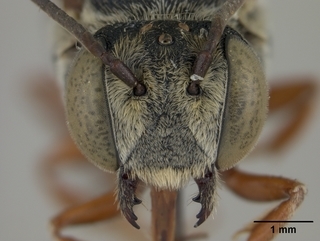
Smithsonian Institution, Entomology Department · 9
Coelioxys galactiae, face |
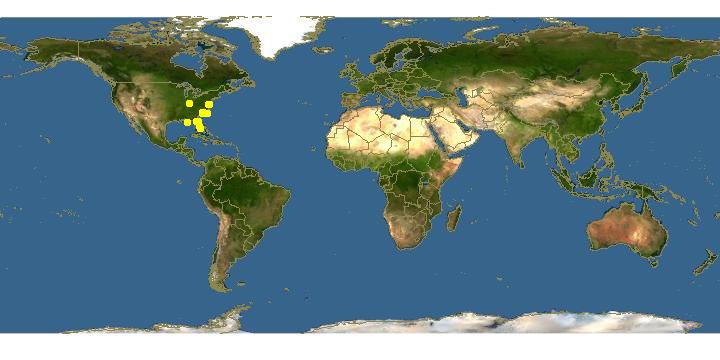
Click on map for details about points.
|
80x5 -
240x3 -
240x4 -
320x1 -
320x2 -
320x3 -
640x1 -
640x2
Set display option above.
Click on
images to enlarge. |
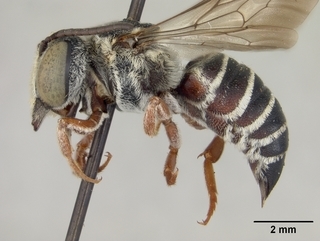
Smithsonian Institution, Entomology Department · 9
Coelioxys galactiae, side |
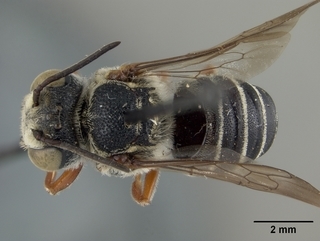
Smithsonian Institution, Entomology Department · 9
Coelioxys galactiae, top |
|
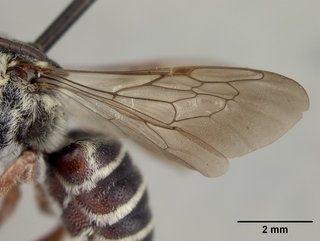
Smithsonian Institution, Entomology Department · 9
Coelioxys galactiae, wing |
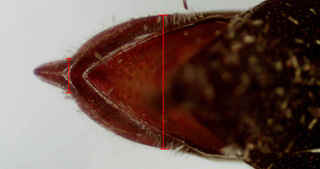
© USDA Bee Biology and Systematics Laboratory, Logan Utah
· 1
Coelioxys galactiae, s6 acute tip and abruptly narrowed posteriorly |
|
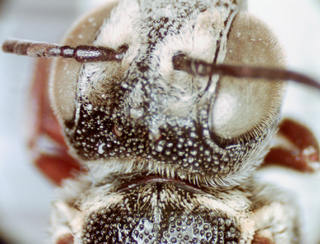
© USDA Bee Biology and Systematics Laboratory, Logan Utah
· 1
Coelioxys galactiae, scutum punctate to anterior margin |
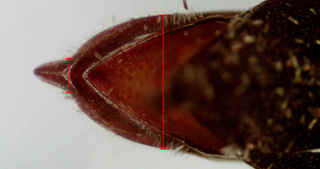
© USDA Bee Biology and Systematics Laboratory, Logan Utah
· 1
Coelioxys galactiae, s6 acute tip and abruptly narrowed posteriorly |
|
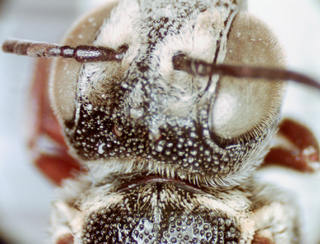
© USDA Bee Biology and Systematics Laboratory, Logan Utah
· 1
Coelioxys galactiae, scutum punctate to anterior margin |
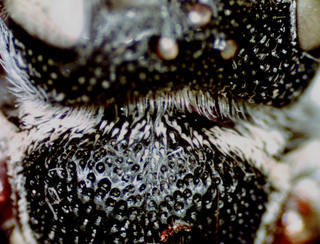
© USDA Bee Biology and Systematics Laboratory, Logan Utah
· 1
Coelioxys galactiae, scutum and head |
|
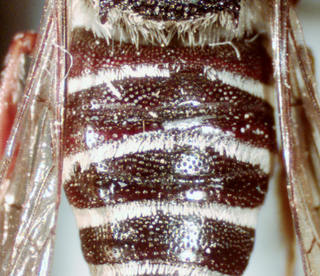
© USDA Bee Biology and Systematics Laboratory, Logan Utah
· 1
Coelioxys galactiae, t2 and t3postgradular grooves |
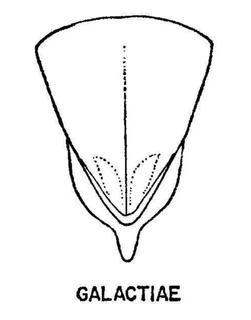
© NC Agriculture State Experiment Station Technical Bulletin Number 152, T. B. Mitchell, 1962
· 1
Coelioxys galactiae, female, abdapex |
|
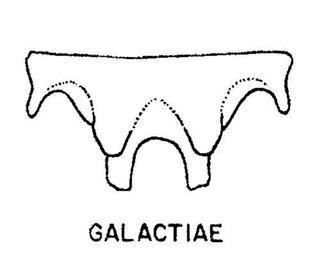
© NC Agriculture State Experiment Station Technical Bulletin Number 152, T. B. Mitchell, 1962
· 1
Coelioxys galactiae, male, T6 |
|
Overview |
Reprinted with permission from: Mitchell, T.B. 1962 Bees of the Eastern United States. North Carolina Agricultural Experiment Station Technical Bulletin No. 152.
FEMALE—Length 10 mm.; black, tegulae testaceous, legs and abdominal sterna ferruginous; eyes slightly convergent below; lateral ocelli subequally distant from margin of vertex and each other, slightly nearer each other than to eyes; cheeks much narrower than eyes, somewhat narrowed below, inferior angle obscured by dense pubescence, this area not excavated; clypeus flat, apical margin about straight, with a rather dense fringe of moderately long, yellowish pubescence; median length of labrum slightly greater than basal width; mandibles distinctly 3-dentate, median tooth approximate to the apical tooth; punctures rather deep and distinct, irregular in size and distribution, but rather close across vertex, cheeks rather irregularly rugoso-punctate beneath the pubescence, face below ocelli quite closely punctate, supraclypeal area rather shallowly and coarsely rugoso-punctate, surface at sides of face obscured by dense, subappressed pubescence, clypeus finely and irregularly rugose beneath dense, appresseci tomenturn; pubescence entirely pale, more or less yellowish around antennae and over face and dypeus, more whitish, quite short and decumbent on cheeks; ventral surface of mesothorax densely white tomentose, obscuring the surface, becoming thinner above but with rather dense anterior and posterior fringes, copious around tubereles, propodeum with more erect, elongate, whitish pubescence; transverse carinae of tubercles erect and conspicuous, testaceoushyaline, extending somewhat along anterior margin of scutum; posterior margin of scutellum only slightly outcurved, posterior and dorsal faces not sharply differentiated; axillae acute, projecting conspicuously from sides of scutellum, length somewhat greater than median length of scutellum; coxal spines reduced to triangular, subcarinate tubercles which are densely pubescent posteriorly; wings subhyaline, faintly infuscated along outer margin, 2nd recurrent vein reaching 2nd submarginal cell somewhat nearer apex than 1st does to base; scuturn somewhat shining between quite coarse and deep punctures, these rather widely separated on each side of center, becoming somewhat finer and closer medially and along sides; punctures of scutellum scattered and irregular, with some rather broad, intervening spaces; punctures of axillae very close and coarse, becoming more reticulate; punctures of pleura rather shallow but coarse and very close in large part, area below tegulae more reticulate; lateral faces of propodeum rather smooth but dull, posterior face somewhat more shining, with rather close, minute and vague punctures beneath the thin, elongate pubescence, dorsal area velvety, becoming quite distinctly and rather coarsely striate along upper margin; basal abdominal tergum shining, punctures quite coarse, close along margin of the concavity, but otherwise rather sparse, the extreme sides densely tomentose and apical margin with a complete, dense, whitish, apical fascia; terga 2 and 3 with complete, transverse, but rather shallow grooves, these sub-basal at sides but becoming more subapical at center, the basal punctures quite coarse, close, regular and deep, the area apical to the groove very sparsely punctate medially, becoming somewhat more closely but coarsely and irregularly punctate at sides, apical margin slightly depressed, with entire, whitish, apical fasciae; terga 4 and 5 rather coarsely and sparsely punctate apically, punctures closer and finer toward base and somewhat closer at extreme sides, apical margins depressed and whitish fasciate; tergum 6 triangular, with a rather narrowly rounded tip, sides very slightly angulate at mid point, a low median ridge extending from near the base to the tip, surface quite deeply excavated on each side of this near tip, and sides rather deeply grooved from lateral angles toward tip, surface somewhat shining basally, with close and fine punctures, these becoming crowded apically, apex more densely rugose (fig. 65); sternum 6 broad basally, abruptly narrowed at apex, thus incurved at each side, the tip subtriangular, more or less acute; sterna 1-4 shining between coarse, close, deep and quite regular punctures, apical margins depressed and yellowish-hyaline, densely and rather loosely white fasciate; sternum 5 narrowly rounded or subtriangular in outline, basal area with rather coarse, sparse, scattered punctures, these becoming extremely minute and densely crowded over apical half, margin narrowly yellowish-hyaline, and fringed with whitish pubescence.
MALE—Length 11 mm.; black, tegulae testaceous-hyaline, legs and abdominal sternalargely ferruginous; eyes slightly convergent below; lateral ocelli very slightly nearer each other than to margin of vertex, somewhat more distant from eyes; cheeks considerably narrower than eyes, carinate posteriorly, with a shining, bare, concave, excavated area below, this fringed posteriorly with rather elongate, curved hairs; clypeus about fiat, apical margin straight but obscured by dense pubescence; median length of labrum somewhat greater than basal width; median tooth of mandible distinct, approximate to apical tooth; punctures coarse and deep, rather close but distinct across vertex and between ocelli, becoming more rugose on cheeks, quite coarse, irregular and rather shallow below ocelli, entire face below antennae densely covered with appressed pubescence which completely hides the surface; pubescence of face yellowish, whitish and rather short and subappressed on cheeks, ventral surface of thorax densely white tomentose, completely hiding surface, becoming rather thin and more erect on pleura above, scutello-mesothoracic suture with very fine, pale pubescence, and anterior margin of scuturn with a pair of transverse, rather widely separated lines of whitish pubescence; pubescence of propodeum thin, elongate and erect, entirely whitish; transverse carinae of tuberdes erect and quite conspicuous, more or less testaceous-hyaline but somewhat obscured by a fringe of pubescence, extending somewhat along anterior margin of scutum; hind margin of scutellum very slightly outcurved, posterior and dorsal faces not differentiated; axillae acute apically, projecting conspicuously from sides of scutellum, somewhat longer than median length of scutellum; front coxal spines robust and well developed, somewhat spatulate, with rounded tips, densely pubescent posteriorly and along inner sides; wings subhyaline becoming somewhat more deeply infuscated apically, recurrent veins reaching 2nd submarginal cell subequally distant from base and apex; punctures of scutum coarse and rather deep, somewhat irregular, slightly separated on each side of mid-line but becoming close laterally, finer anteriorly; punctures of scutellum irregular, much like those of scutum, to some degree separated; axillae very coarsely, contiguously punctate, almost reticulate; pleura irregularly and rather closely punctate, punctures rather shallow, more definitely reticulate above; lateral faces of propodeum rather smooth but dull, posterior face somewhat more shining, with very minute, widely scattered, obscure punctures, dorsal area velvety, becoming rather narrowly and coarsely striate along upper margin; basal tergum shining between coarse, close and deep punctures, these quite regularly distributed, surface obscured by a narrow patch of dense tomentum at each extreme side, apical margin with a complete, dense, whitish fascia; terga 2 and 3 with deep, distinct and complete transverse grooves, these sub-basal at extreme sides but more median in center, the basal punctures coarse, close, deep and regular, apical portion of disc somewhat irregularly and sparsely punctate medially, becoming more coarsely, closely and punctate at sides, apical margins deeply and with complete, dense, whitish fasciae; terga 4 and 5 densely white fasciate across the base, apical margins deeply fasciate only toward sides of 4, only a trace on extreme sides of 5, surface somewhat shining, punctures coarse, deep rather sparse at center, becoming closer tergum 6 densely tomentose across deeply excavated in center, the dorsal very short, broadly rounded carinate, quite strongly divergent, ventral spines very short, subtruncate, the intervening space regularly rounded, lateral
somewhat compressed, the tips rounded 66); sterna 1-4 somewhat shining between coarse, deep, regular and rather close apical margins depressed, yellowishhyaline, quite densely whitish fasciate, on 4 quite narrow; disc of sternum 4
slightly emarginate apically, but the depressed rim also with a slight, median, apical eniargination; sternum 5 largely hidden, apical broadly incurved, surface in general densely pubescent; sterna 6 and 8 entirely submembraneous; penis valves genital armature quite robust, about equalling gonocoxites in length, the latter somewhat compressed, slightly dilated apically, bearing numerous, elongate and erect hairs toward apex.
TYPES — Holotype: Female, 10 mi. S. Lillington, N. C., June 23, 1937. Allotype: Topotypical [both author’s coll.]. Paratypes: NORTH CAROLINA: 3 ♀♀, Lillington, July 7, 1938; 1 ♀, Hoffman, July 4, 1928; 1 ♂, Holly Shelter, Pender Co., June 8, 1950 (on Amorpha); 3 ♀♀, Topsail Isl., Aug 3, 1955 (on Galactia); 1 ♂, West End, Moore Co., June 14, 1950 (on Asciepias tuberosa); 1 ♂, Wilmington, June 20, 1952 (all Mitchell); 1 ♂, Salvo, Dare Co., Aug. 6, 1958 (K. V. Krombein). ILLINOIS: 1 ♂, Chicago, July 15, 1899 (Percy Gardner Bolster coil.). FLORIDA: 1 ♀, Gold Head Branch St. Pk., Clay Co., May-June, 1954 (L. H. Krombein). 5 ♂♂, Levy Co., July 13, 1954 (H. V. Weems, Jr., on Eriogonum tomentosus).
Paratypes are in the U. S. National Museum, the Museum of Comparative Zoology and the author’s collection.
Extracted from: Baker J.R., (1975). Taxonomy of Five Nearctic Subgenera of Coelioxys (Hymenoptera; Megachilidae). The University of Kansas Science Bulletin Vol. 50, No. 12, pp.649-730.
FEMALE. Agrees with description and figures of Coelioxys edita except as follows: (1) Length 9-11 mm; (2) integument granular on vertex, thorax; finely rugulose on metasoma; black; antenna, tegula piceous; mandible, venter and dorsum (basally) of metasoma black to rufous; legs rufous to ferruginous; (3) pubescence white, yellowish on face, golden on tarsi; (4) ocular hairs short (about 0.06 mm); (5) clypeus almost flat, margin with 4-6 denticles obscured by apical fringe; (10) ocellar area moderately punctate anteriorly; (11) interocellar distance slightly greater than ocelloccipital distance, less than ocellocular distance; (12) vertex punctured as in Figure 10; (13) gena constricted ventrally; surface almost obscured; (15) mandible as in Figure 22E; (16) scutum punctured as vertex in Figure 10; anterior fascia indistinct; (17) lateral margin of mesepisternum moderately punctured, fasciae distinct; (18) scutellum sparsely punctured; (19) axilla without conspicuous carinae; (22) tergum 1 with basal fascia inconspicuous; postgradular areas less closely punctate than pregradular areas; tergum 6 narrowly rounded apically (Fig. 38C); (23) fascia of sternum 5 sparse but complete medially; apical portion of sternum 6 longer than shown in Figure 38A (Fig. 38C).
MALE. Agrees with description and figures of Coelioxys edita except as follows: (24) Length 9-10 mm; (25) integument as in female (2 above); (26) pubescence white, yellow on face, golden on tarsi; (32) clypeoantennal distance greater than antennocular distance, less than interantennal distance; (33) ocellar area as in female (10 above); (34) ocelloccipital distance greater than interocellar distance, greater than ocellocular distance; (38) mandible as in female (15 above); (39) scutum moderately punctured; (40) mesepisternum moderately punctured, almost obscured by setae about 0.45 mm long; (41, 42) scutellum, axilla as in female (18 19 above); (45) gradular groove of tergum 4 with conspicuous fasciae laterally; tergum 6 with apical spines slightly more elongate than shown in Figure 39G; (47) sternum 4 with subapical carina indented medially, apical margin bidentate as in Figure 390; sternum 6 as in Figure 39A; sternum 8 with base about half as broad as shown in Figure 39C; abundant setae apically on gonocoxite (Fig. 39N).
DISTRIBUTION AND SEASON OF FLIGHT. Coelioxys galactiae is confined to the eastern United States (Fig. 41).
This bee is in flight at least from June 23 to August 6.
HABITAT. Coelioxys galactiae has been collected from areas classified as a mixture of bluestem prairie and oak-hickory forest (Andropogon, Panicum, Sorghastrum, Quercus, Carya), oak-hickory forest, oak-hickory-pine forest (Pinus), southern mixed forest (Fagus. Liquidambar, Magnolia, Pinup, Quercus), and pocosin (Pinus, hex).
COMPARATIVE COMMENTS.
This bee is similar to Coelioxys edita but differs by the more attenuate sixth sternum of females (compare Figs. 38C and 38A) and more attenuate apical spines of males (longer than shown in Fig. 38G). Also the axillae of C. galactiae in both sexes are not carinate and are more sparsely punctured than those of C. edita (Fig. 37A).
|
|
|
Names | |
|
|
| Supported by | |
Updated: 2024-04-26 20:04:36 gmt
|